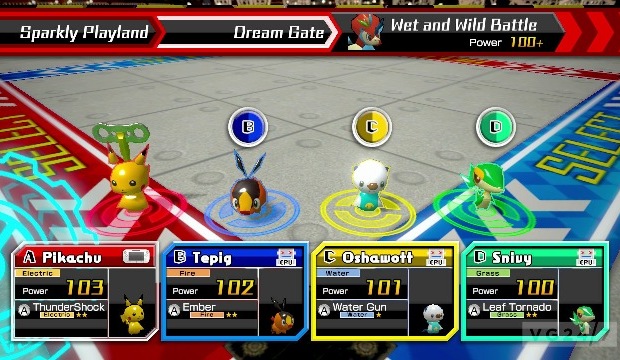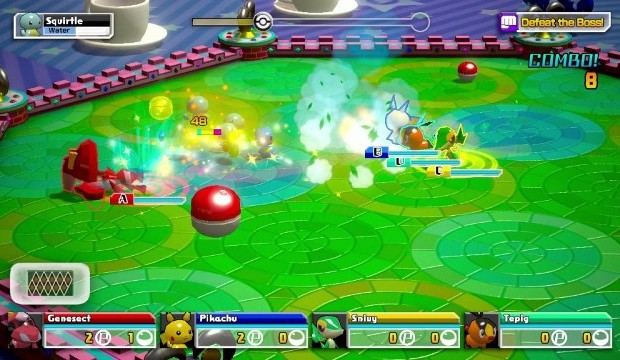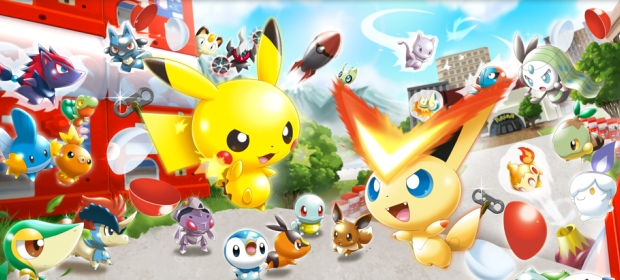After many chequered years of film and TV spin-offs, toys, trading cards and playground fights, it seems hard to believe that it is only now in 2013 that we bear witness to the first Pokémon videogame in HD. With Nintendo stating that they have no plans to bring the canon RPG series to the Wii U, the pocket monsters debut on the flagging console is Pokémon Rumble U – the third instalment in Ambrella’s simple brawling side-concern.
Last time out, the toy Pokémon that inhabit the Rumble-verse were out to play on the 3DS, in a mixture of scrolling sections and arena battles that was mildly diverting but not worth the full retail asking price. For Rumble U, Ambrella have kept the same button-bashing, mildly repetitive gameplay and simplified the formula even further – removing the scrolling sections and the ability to switch your characters in real time.
Making an already basic affair even more so could have been a disaster, yet the way Rumble U is structured actually works very well and it has turned out to be a very fun pick up and play distraction.

It looks absolutely gorgeous, colourful, shiny, bright – in other words exactly how you would have imagined Game Freak’s characters to look in HD. There are such a huge variety of different Pokémon but each one is rendered with great detail and animated to a fine standard. That is just the in-game stuff; the action is bookended by some sumptuous anime-style sequences that capture the whimsy of the toys-based plot perfectly. The music is similarly impressive: there are some staggeringly catchy tunes at play here, including some themes from previous Pokémon games that fans are sure to recognise.
Beginning with the same clutch of basic Pokémon toys from Rumble Blast, you enter into arena battles with a slew of baddies, which involve four allied Pokémon joining forces to defeat a bunch of smaller enemies, every stage culminating in a boss fight at the end. Each battle arena will have certain conditions to meet, such as “Use Both Attack Types” or “Collect 5 Poké Balls”, as well as a number of unlockable Pokémon that you gain by picking up Poké Balls dropped by downed foes. These are entirely random, and at the end of every stage you are transported to a screen with a wonderfully unexpected old-school drum and bass soundtrack in which your Poké Balls are split open to reveal the monstrous spoils of your battle. Enemy critters also drop coins – which can be used to “buy” Continues if your energy bar is depleted and you conk out – as well as restorative sweets and status-enhancing power ups that do cool stuff like double your toy’s attack power.

In single player you can choose your own main character as well as the remaining three AI-controlled beasties. The AI isn’t brilliant, so be prepared to do most of the damage yourself . In the incredibly fun local multiplayer – and in single player mode, although it is less consequential in terms of bragging rights – you effectively compete as well as collaborate with your cohorts, with extra points awarded for things like most enemies dispatched, least damage taken, Poké Balls collected and the crucial first and last strikes. At the end of each round the four teammates are ranked, meaning that if you want to play with a competitive edge you find yourself keeping an eye not only on battering foes but snaffling up the Poké balls in what becomes a fun – if at times slightly confusing – melee.
There are a staggering 600+ Pokémon to track down, some of which are randomly dropped, others unlocked by meeting the in-stage conditions. All of them follow the tradition of having some kind of elementary alignment – and this can affect your performance in battle. Matching the right toy to an enemy (such as a Water-based dude like Blastoise to a Fire enemy like Charmander) can lead to your character landing devastating “Super Effective!” attacks. Most toys have two different attacks, and it’s a great deal of fun testing out their effectiveness (or lack of) in battle. The screen in which your available toys are displayed is useful in that your phalanx of employable monsters are arranged with the most powerful at the front. As you pass through the stages you will want to make sure you’re taking your most badass toys with you, lest you end up getting owned by the increasingly more difficult and hectic swathes of enemies.
Gone from previous titles is the ability to upgrade your special moves using coins – but this levelling up can still be achieved by different, and rather exciting, means. Available to purchase at additional cost at launch are Skylanders-style figurines that tie in with the Near-Field Communication abilities of the Wii U Gamepad. There are 18 figures to be released in total – including favourites like Bulbasaur and Pikachu – and each will allow you to customise move-sets, power up your on-screen toys, and store information about your custom Pokémon on the chip inside the figure. The use of the NFC statues is strictly optional, and we were unable to test them at time of writing, but something tells us that the marriage of the successful license to tech that has proven wildly popular with kids and adults alike elsewhere could be a recipe for success for Nintendo.

VERDICT: Pokémon Rumble U is a very simplistic game, but a very fun one. The “Catch ‘Em All” fever really gnaws away at you with a vengeance here as you aim to complete all of the challenges on each stage and find all of the hidden beasties. There are so many different characters to try, and the added bonus of being able to play with up to three Wiimote-clutching friends. It is full of cheer, bombast and likeability – a perfect downloadable breeze of a game that all of the family can enjoy – with the prospect of intriguing NFC figures providing future content to try out.
Gameplay hasn’t moved on from the 3DS version; the combat is mostly about mashing the buttons with tactics taking a back seat. As much as we criticised Rumble Blast, it would actually have been nice to have kept the Battle Royale mode from that one. In spite of this, keeping the focus on the superior arena battles rather than plodding scrolling sections, and implementing a more fun, competitive multiplayer, has made for a much better game that represents much better value.

GOOD. A game that scores 7/10 is worthy of note, but unworthy of fanfare. It does many things well, but only a few of them incredibly well and, despite a handful of good qualities, fresh ideas and solid mechanics, it fails to overwhelm.





